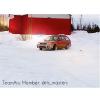Search the Community
Showing results for tags 'oil'.
-
Hello, At work right now so my full research will start when I get home, but figured it would be nice to have some pointers of where to look in the forum ( keywords, etc) and maybe where to look on my car to better assist my research phase. **my 1998 subaru Outback 2.5l auto with about 130k miles popped check engine light. -Drove it about 12 miles, checked fluids ( oil, Brake fluid, trans , coolant ) all looked good. - pulled battery Cable to try and reset light in case it was a one time thing. -Reconnected battery, Started car , idled until temp guage started reading, still check engine light. -Turned off car fluid check again . . . oil was way low, looked under car, 0.5 + quarts dumped right under the car. seemed to be coming from Driver side left of engine above the lower Radiator hose connection behind the plastic cover that is behind the belts. Wondering if it ends up being a big issue if swapping from the 2.5 to the 2.2 is a common thing ? The research and Adventure now begins! Any thoughts, questions or pointers would be awesome. ( will be doing a photo bucket account or the like to get plenty of photos flowing :0)
-
Hello I recently bought a 1985 GL Wagon 1.8 liter 5 speed. It has 120k miles on it. I know it has some good life left in it. The previous owner didn't keep it up very well. I don't have the service manual for this car. I decided to change the transmission fluid and the oil and filter, along with the starter distributer cap, plugs and wires. The guy at the auto parts store looked up the amount of fluids needed for the oil and transmission fluid. He stated that the transmission needed 7 quarts and the engine needed four quarts. After finishing all other projects. And filling the fluids up,... It definitely seems to be way too much in fluid amounts with the oil and tranny fluid. If anyone can give me the recommended amounts for tranny fluid and oil that would be great. The oil is easy I guess, just fill it up till it's right on the dipstick. By the way the tranny fluid looked really bad as well as the oil. Thank you, Chris
- 2 replies
-
- Transmission Fluid
- Oil
-
(and 3 more)
Tagged with:
-
Hello everybody! I've recently picked up a 1994 Subaru Loyale for $200 - needed timing belts. I pulled the engine out of the car and did a complete gasket rebuild. While it was apart I noticed parts came out of the camshaft housing/assembly. The parts looked like some sort of oil pressure valve, a spring, a pipe, and a bolt. I did what little research I could and i believed i was able to correctly re-assemble the engine. Eventually got the car running, and I had a horrible ticking sound coming from the drivers side cam housing area. I read that it could be mis-seated rockers and that it could possibly go away with some driving, however mine didn't. engine died while idling and wouldn't start back up. I pulled the engine apart AGAIN only to find that my drivers side cam looks like it was never getting any oil, and seized. What would cause that cam not to get any oil and seize up? I have a new cam and housing ready to go in, but i'd like to make sure I don't have the same problem again. One other thing i noticed is when i pulled the camshaft housing off, oil was coming out of one of the bolt holes in the head. (where a bolt for the cam housing goes into) is this normal? I can post any pictures if anybody feels they would be helpful. just don't have any on this computer at the moment. I greatly appreciate any helpful tips, pointers and advice! I've replaced the following items. - Water pump - Oil pump (OEM straight from subaru) - Timing belts, tensioners and pulley - Full engine gasket set Thanks again!
-
hey everyone, just a quick question, does the oil in/out of these turbos need pressure to flow (does the turbo pump the oil? or does the engines oil pump supply the flow) same with coolant, i figure the coolant system is always under a certain amount of flow since the pump is always spinning, but does the turbo circulate water or does only the engine circulate it through the turbo? thanks in advance!!
-
Hi all, first time posting, seems like a great community. The problem: I have a 2001 Subaru legacy L. It has 190K on it, mostly highway miles. It needs its head gaskets done, but I just took it into a shop and the repairman said it wasn't looking too bad, they were seeping but not leaking. Driving home from work yesterday it started to overheat for the first time, temperature gauge got up to H but did not redline. Managed to coast pretty much all the way home (downhill) and let it sit in my driveway for awhile. Checked the oil and coolant levels and they both appear to be fine. Oil is maybe a tad high (slightly above F). Took off the radiator cap (with engine cool) and it bubbled and then was still. It seems like there are little copper flecks in there, not sure what those are from or what they indicate. Don't seem to see any of the notorious white sludge in my coolant that would indicate that the head gaskets have blown. Recently (May) replaced the radiator and thermostat, so I wouldn't think those would be the problem, although I'm not too sure on the longevity of thermostats. Looking for some help on diagnosing the problem! Might just be time to go get the head gaskets done? Thanks for any help!
- 13 replies
-
- 2001
- Subaru Legacy
-
(and 6 more)
Tagged with:
-
I drove to work. Everything was fine. Then I'm told there's oil under my car. I checked the dip stick and I only have a bit less than full. That said, my car has a drip or few every couple days. It isn't dripping oil in this huge spot anymore. Does anyone think this released from the oil pressure relief valve or do I probably have a bigger problem? I will update the post as I find out more. I have to get my car to level ground at the end of the day and check other fluids. (The second small puddle in the back is AC condensation. Water.)
-
does anyone know what fluid goes in the 5 speed dual range 4wd manual transmission? its out of an 88 GL. i accidentally spilled most of the fluid while the transmission was disconnected.
-
i have a 2wd subaru wagon with 187k miles it leaks oil, what type of oil should i put into the car?
-
i have a 2wd subaru wagon with 187k miles it leaks oil, what type of oil should i put into the car?
-
Hello all, I've had my 2006 Impreza for about four years now. Since I've owned it, I've gone through several headlights (about three per year; alternating passenger and driver). I also go through oil like a hole in the head, despite having all head gaskets replaced about two years ago. Additionally, my emergency brake light has not gone off in about 6 months. What gives?! Are these common problems with my make and model?
-
Does anyone have experience with the engine siezing? There was plenty of oil and the dealership told me that it looks like a valve spring failed and caused the catastrophe. Short block and pistons being replaced, ancillary parts being rebuilt or reused. Any other concerns here? Had I been 5ft further, I would have been in the middle of a busy road. Anther 10 miles and I would have been on the highway. Kind of freaked out here...
-
I have a 2007 subaru outback. 203k miles. Timing belt was changed in dec 2013. since April we have had issues with the oil. Right before due for an oil change around 2k the oil would just disappear and the check engine light would come on showing P0026 and p0028. We would change oil filter and oil and itd do fine act normal light went off until abt 2k again changed it again used better oil and filter lasted 3k before light came on. This last oil change we threw in some lucas suppliment oil also. Now check engine light is reading same codes and P0420. Catalyst below threshold. any idea to whats wrong? it holds this oil til tht very last moment then its gone.
- 7 replies
-
- P0420 P0028
- P0026
-
(and 1 more)
Tagged with:
-
I bought a 1998 Subaru Legacy Brighton a few weeks ago needing "a clutch and an oil change." While it does need both, there is also an oil leak i cannot trace. My entire underside was oil on it, but the drip is dripping off of the oil pan, where most of the oil is coated on. I think it's either the plug/plug seal, the gasket, or the oil pan itself. If i replace that, i would do all of those, but i wanted to know if there are any other possibilites for issues before i invest in that. Here's the leak at the oil pan:
-
I have an 85' GL non-turbo wagon with 140,000 miles (stock carbureted). It runs great, but has had an issue with oil getting into the air filter housing (especially going around corners). The driver-side PVC hose coming off the valve cover is going to the t-fitting which connects to the PCV hose/valve. There doesn't appear to be much, if any suction to the driver-side hose unless the other side of the t-fitting is plugged off. Is this normal? The other side of the t-fitting has a smaller hose, which goes to the air filter housing and looks to be designed to suck fresh air from the housing. Perhaps the suction increases at higher rpms with the small side of the t-fitting uncapped. Is this normal? I noticed the other day, while inspecting the passenger side hose that this pictured green plug was inside of the hose and popped out when I removed the hose from the air filter housing. The plug is soft rubber and is about the same diameter as the inside of the hose. I also found, inside the hose, a couple of pieces of black electrical tape that I'm guessing the PO wrapped around the plug. I thought that the PO had put the plug in the hose for some monkey reason, so I removed it and drive around with no ill effect until I took a long high-speed left turn which resulted in a quart of oil in my air-filter housing. Wtf? Is this plug stock? If so, where is it supposed to go? With the motor running, pressure can be felt coming from the passenger side hose/valve cover, but not the driver side. Is this normal? With the PCV valve sucking (small end of t-fitting plugged), no air is being pulled through the passenger side hose, but rather a decrease in pressure blowing out of the passenger side. Is this normal. I'm at my wit's end with this issue. Anyone know of a good old-school Suby mechanic in or near Yakima? The guys at my local dealer did not impress me as knowing anything about the EA82s. Help
-
My 95 Legacy recently rolled over 300k and im about due for a oil change also trans/diff. I have changed oil with 15-40w last couple times and added some Marvel mystery oil. I went with 15-40w due to the high miles with no issues & before I used 10-40w no problems. My question is should I stick with the 15-40w dino oil or should I change viscosity and/or to a full synthetic/blend? I have read a few guys use the 15-40w in there cars and a shop my friend worked at would use 15-40w in all the older EJ22's & 25's that went thru. But I've recently read that 15-40w doesn't lube as well as thinner oils & that the cleaners in it can be harmful to non-diesel engines. Also what are your idea's about adding a little 80-140w to the 75-90w(80-90w) for the trans/diff to help cushion older parts?Or Is there a good additive to use for this?
-
Freezing coolant(water) killed my car?!
82GLWag posted a topic in Old Gen.: 80's GL/DL/XT/Loyales...
Ok so I know I could have avoided this by running coolant. So really i just let the cold kill my car.. But my radiator has had a mean leak so I've been topping it off with water almost daily. It's a ea81 82' GL. Below freezing temps hit and froze all the water. Yesterday it happened aswell I started it up and the belt was squeeling on the water pump pulley so I shut it off then topped off the radiator with warm water and let it sit for a minute. I turned the pulley by hand to make sure it was not frozen and started it up. Warmed up fine and drive me to work and back. Today I start it up and same thing, all frozen. I let it run for about 30 seconds with the belt slipping on the frozen water pump pulley. Shut it off and added some warm water to melt the ice. It took a LOT of water this time. All the ice seemed to be melted. Turned it over again and it ran very rough the while motor was vibrating like it never has. I shut it off for a minute and turned it over again to have it start very rough and make one or two terrible knocking/clanking noises then die. Then it just wouldn't turn over at all like its seized/locked up. I pop the hood to find oil/water mixture oozing out of the intake!?? Into the air cleaner box. The water in the radiator had oil mixed in aswell. I know this is bad but my question to you is what's my damage?? I'm fairly new to cars so please bare with me. Thanks in advance ! -
Hi all, Current vehicle of question: 1999 Outback Wagon, 2.5l DOHC, 120k, Second owners... This is a friend's car that I'm helping out with, and am hoping to get some good insight. Knew that this would be the place. Story: The car was bought last October, and has had 9000 miles put on it by a very calm and defensive driver... They started noticing the thermostat indicating it getting hot. After watching it, they noticed the coolant was low, and that they needed to add. Then they noticed air being forced into the coolant reservoir. They took it to a few independent subaru shops, and got the same answer: Blown Head Gaskets, and bad Viscous Coupler (for a different post....). So we pulled the motor, and started getting the heads off. It had the old style HG (http://allwheeldriveauto.com/subaru-head-gasket-problems-explained/), and they were both bad My question has to deal with the driver side head in particular... While taking the intake camshaft retainers off, a pressurized aqueous solution squirted out at us from under the retainers. Also, two of the camshaft retainer bolts were heavily corroded. Is this a sign of a cracked head? I plan on submerging the head in a tub of water, and spraying compressed air into the retainer bolt holes. If there are bubbles from anywhere, I'm assuming the head is bad? Should we be concerned with the block internals being compromised? How much should another head cost, and should they just slap a 2.2L in there (I'm in favor...)? The oil that we drained from the pan is not chocolaty/frothy. And there was maybe a gallon of coolant that drained out of the system. Thanks, Greg
-
Hey folks, So I finished my EJ22 swap into my '92 Loyale, and hit the road. Thankfully for me, I'm on my way back... Just have to say, for a motor that had 230k miles, power is great. But I think the rings are bad, being that I'm having to replace oil if I travel at rpm's above 3k... But, my DILEMA! While driving at sustained interstate speeds, there is an intermittent popping/thudding coming from the floor near the gas pedal and the passenger's left foot. You can hear it, and if you put your hand as far up under the dash by the gas pedal, and also by the passenger's left foot.. You can feel the thumping. It feels like something his flapping around and hitting the shell of the car... I have already gotten under it. There's nothing hanging/loose. I started trying to move everything/anything I could get my hands on. Everything feels fine. Nothing wiggly/jiggly. The noise reminds me of the first few corn kernels that start to pop when making your own popcorn. Just kinda sporadic. The vehicle is performing well. No error codes. Fuel economy is in the low 30's right now. No problem accelerating up a hill, All gears work, although I think that the synchronizing gear for third is beginning to ware. I've been trying to trigger/kill the sound. I hear it after sustaining speeds, then if I downshift it'll stay through each gear until I'm about ready to come to a complete stop/put transmission in neutral. I tried taking it out of gear and coasting for a while. Makes it go away for about ten-20 minutes of high speed . BUT, at the same time, I experimented with a coast-to-stop as soon as I heard it next. Well I kept it in neutral, and revved it up and down while coasting. The sound/thump/pop would start and fade. Doesn't happen in City traffic. Also noticed that my speedometer has to catch up sometimes while hitting interstate speeds.. I was wondering if the coolant lines could be popping? I feel like it's in the same area as the heater core as well? Could there be an air bubble in the system? I've had to replace about 3oz of coolant every so often since putting the motor in. No white smoke. Any advice or help would be greatly appreciated. Greg
- 20 replies
-
- Transmission mounts
- Transmission
-
(and 3 more)
Tagged with:
-
This is not a scientific article; the main purpose is to give you the general idea regarding different motor oils, and how to wisely chose the proper one for your car's engine; also understanding how they do their job, and more... Don't do this! In this Article: ♪ Understanding Motor Oils ♫ Understanding Classification and Nomenclature ♪♫ How to Wisely chose between the Manufacturers given numbers ♫♫ Differences between Mineral and Synthetic Oils, and types of Synthetics ♫♪♫ and Much More! ______________________________________________________________________________________________________________ Motor Oils, Basically Does all these Things: ► First: Engine Oil stops all the Metal surfaces in your Engine from Grinding together and Shearing themselves from Friction, by Lubricating its internals. ► Second: Engine Oil transferes the Heat away from the Combustion cycle. ► Third: Engine Oil must also be able to Hold in Suspension all the Nasty by-products of combustion, such as Silica (silicon oxide) and Acids, also External contamination, such as Dust. ► Fourth: Engine Oil minimises the Exposure to Oxygen and thus prevents Oxidation at Higher temperatures. It does all of these things under Tremendous Heat and Pressure... Part one: the Proper Viscosity & Thickness (SAE Grade) Recommended for your engine. SAE = Means a Standard of the Society of Automotive Engineers. Remember: The viscosity of a fluid describes its resistance to flow. Heavyweighted fluids such as honey have high viscosity and flow very slowly, while Lightweighted fluids such as water have a low viscosity and flow much faster under the same conditions & temperatures. But in the Motor oil World, Viscosity is somewhat confused with Thickness, and those are two different things with different meanings. ☼ Viscosity depends strongly on temperature and is a major factor in the Flow of the oils. In example, the specification “10W~30” (“W” means “winter”) in a motor oil means the viscosity of the oil at 0º C (32º F) is no more than 3.1 poise, while the viscosity at 100º C (212º F) is no less than 0.1 poise. Naturally, all oils gets thin and flows easily when they are at high temperatures and pressures. (Normal working conditions inside any engine). But modern Oil formulas are designed in Labs (Mixed with special additives), to have certain compensation to that thinning, to keep doing their job properly under high heat and pressure. I will explain how this compensation occurs, below. ☼ Thickness of the oil, is about the oil Barrier it could lay, inbetween moving metallic parts to prevent Shearing. It is the "cushion" that bears the friction between moving metal parts, the greater number means thicker "cushion" but, you should keep in mind that the tolerances between moving metallic parts, not always allows a "Thick" oil to flow properly; that is the reason why certain manufacturers, indicates to use -in example- a 5W~20 (Thin) motor oil, while other manufacturers indicates to use a 20W~50 (Thick) motor oil, on same displacement engines; (Compare older engines with up to date ones). You shall never exceed the numbers given by the car's manufacturer, or the engine internals' tolerances will not allow the oil to flow properly / in time, nor to do its job as it should, causing damages to the engines. Obviously, hot oil will flow better than cold oil, but here... ...you can see how they Behave at 0º C (32º F) ► Multigrade oils have the ability to compensate the natural thinning of their molecules, that normally happens with Heat, so they gets their molecules to grow Thicker when they're exposed to the internal temperatures of a working engine; in that manner, multigrade oils compensates the natural fluid's weight reduction due to the heat exposure; in example: A 10W~40 Oil will behave as a grade "10" oil does at Cold-to-Ambient Temperatures, and will become thicker and behave as a grade "40" oil does, when it it exposed to the heat of the engine at its normal operating temperatures. So those oils with a "W" on their SAE Grade, are "Multigrade" Oils, (W for Winter times) their first number on their SAE grade is the "cool temperatures" number: Thinner oil helps to the engine's oil pump to move the oil faster during cold starts when engine is Cool and thus means less shearing by friction during cold starts. But the Oil's molecules will become thicker with heat, so the same oil will behave as the Second Number, intended for "hot temperatures" on their SAE Grade, when the engine Reaches its Normal operating Temps, compensating in order to have enough protective oil film "Cushion" between moving metal parts and prevent shearing. Want to learn How the Oil "Thickness" protective layer prevents Shearing on your Engine? ... Download the .pdf file document at the Bottom of this Page, you can see tests' results with Photos on it. The oil barrier thickness increases with Heat due to the Polymers that where added to the Oil, those absorb temperatures; also Thinner Oils will increase the Oil Pressure on the engine and that is really needed on Cold Starts, to help the Oil to Reach the Farther engine's places, Faster. How do Multigrade oils get Thicker with heat? The answer was given by Mobil 1: Here: ~► http://www.mobiloil.com/USA-English/MotorOil/Car_Care/AskMobil/Multi_Viscosity_Oils_Long_Molecule_Thicker_Oils.aspx ► Monograde Oils (Single SAE Number) will not vary at all and will behave the same at all the temperatures' range; unless it becomes Very hot, when its Thickness 'Could be' Reduced, it is known as "Oil Break Down" ... (more noticeable on Cheap brands with poor Quality) ... That is the inverse situation and could be Harmful for a Very Hot Operating or for an Overheating Engine: That oil under that conditions could Lost its main Lubricating Properties. I Really advice against the use of Monograde oils on Cars, because they Won't flow properly on Cold Starts, remember: Those parts that worns faster inside the Engine are those parts that doesn't get Oil fast enough with Proper Pressure; so a Multigrade Oil will Reduce both the Time working without Oil on Cold Starts and the low Pressure. Monograde oils could still be good for Power Plants, 18 wheels' trucks, etc... But Not ideal for a Car's engine. Keep the Proper SAE Grade in Mind when you Buy your Next Oil. Be Careful with the Viscosity Grade! The Oil Pumps only creates flow, not Pressure; the Pressure exists due to the Resistance on the engine's internals to such Flow; and the hydrodynamic film strength is what prevents metal to metal Shearing. A thicker oil will increase oil pressure in any engine, but only to a point, due to the Oil Pressure Relief Valve that will simply route oil back to the pan after Reaching certain pressure on the System. So, since Pressure is resistance to flow, a 20W~50 motor Oil will increase pressure, but it means that it does not flow as well through the bearings nor to the top of the motor, causing the Low Pressure problems, let me explain: Considering that a 20W~50 oil is 3 to 4 times thicker cold than a 5W~30, when a Cold engine is Started, there will be Restricted oil Flow when it is needed the Most: the oil relief valve will Cut the flow further by opening at the higher pressure and dumping oil back into the pan. In some engines it will take Longer for the oil to get to the cam shafts, and the Small diameter hole in the middle does not facilitate the Flowing to the high viscosity oil. Since the oil flows from Front to Rear on the cam shafts, it is going to take the last Cylinder valves the Longest to get the oil Flow Needed. The oil squirters spray pattern on the cylinder walls will degrade with a high viscosity oil, especially in cold conditions. While a thinner motor oil keeps the pressure in the upper engine, because the pressure is less than the oil relief valve's top pressure, and the system gets well presurized faster. Remember that the Automotive industry changed their way of thinking regarding Engines. In the past, small displacement engines were designed, keeping in mind that they were built to be used in compact cars; and "Long Lasting" was their main concern, as automotive makers wanted to make a reputation; so Older engines are more "loose" which means that their tolerances -the space inbetween moving metallic parts, and tiny passages- was greater, and could be filled easily with thicker motor oils; that is the reason why you can read in the owners' manual from an average 1.8L engine from the 1980's decade, that 20W~50 was usually the oil recommended to be used. If automotive makers wanted performance and high horsepower output, they had then the six cylinders and eight cylinders' engines with Big Displacement, intended for "Performance" you know... But, the automotive industry of nowadays, is using pretty small displacement engines to move big cars, you can see big SUV's with in-line four cylinder engines that has small displacements, but having high power output, rounding the average Hp of a V6 from the past; and what they did to achieve such goal, is -basically talking- to make their engines "Tight" by reducing Tolerances at their minimum, and use metal alloys that resist such kind of internal pressures; but they requires pretty "Thin" Motor Oils to lubricate properly such engines with tight tolerances; that is the reason why you can see 0W~16 and even 0W~8 motor oils on the autoparts stores, nowadays... Long story short: Despite that a 20W~50 motor oil, provides a better "Cushion" between metallic moving parts, to prevent Shearing; you can Not use such a thick motor oil on an Engine that was not designed to be Lubricated with it; tight tolerances will never allow it to Lubricate and do its job as it should; that is the Reason why you should always respect the Manufacturers' given Numbers in your user's Manual, and if they provides various option, Choose wisely (keeping in mind the environmental / climate temperatures of your area), from the numbers given. Part Two: The Motor Oil's Quality. The American Petroleum institute API Has Two ways to classify Motor Oils: the Gasoline Motor Oils are clasified under the "S" Letter (From "Spark" combustion engine) While Diesel engine oil is clasified under the "C" Letter (From "Compresor" Combustion engine) The API has a program to certify that the Motor oils, meets the strict Performance and quality standards put in place by the OEM. The Service Rating is shown in the API “Service Seal” on the product label, that may look like one of these examples: So, The letter that follows the "S" or the "C" will let you know if the Additives Package (Detergents, Dispersants, Stabilizers, etc... ) is Better or Worse for your application. Any Letter from "A" to "Z" could be next to the "S" or "C" Letter, the more Newer Classification will place a higher Letter there, as Follows: GASOLINE motor oils must read as Follows: SA = Early -older- motor Oils, Very Basic and without any Additive. (then the classification continued with: SB, SC, SD, SE, SF, SG,SH... etc...) SN = Very Recent Classification, includes a Complete Additive Package for Gasoline Engines under the APi Norm. DIESEL motor oils must read as Follows: CK = -or any other Letter instead the "K" like "F", etc.- (Could have a Number 2 or 4 Next to it) The CF or CF-4 are for regular Four Stroke Diesel engines. CF-2 (and other classifications bearing the "-2" symbol) are oils for especial Two Stroke Diesel engines. Beware of those Cheap oils, usually with unknown brand, due to their Lowest quality, in example this one, despite of being "Made in USA" is the worst thing to happen to any engine, besides of running out of oil: ► Important Note: if a DIESEL Motor Oil has, Besides its CK, CF, CG or CH Diesel oil APi classification, any "S" Classification (Such like "SN") , also you can pour them on Gasoline Engines; those kind of oils are commonly known as "Fleet Oils" ... in fact I've been using 15W~40 Fleet Oil from Chevron, the "Delo 400" since many years ago in many EFi cars, with excellent results, because those kind of oils has a very High value of Zinc, which is really needed to prevent wear, especially in older engines, while a Standard "Gasoline Only" motor oil, might comply with the same APi Class, but lacking the needed Zinc additive. But if the Diesel Motor Oil Doesn't have any "S" (such like SL or SH or SM) APi Classification, then Avoid pouring it onto ANY Gasoline engine, those are "Diesel-Only" motor oils. I Kindly Suggest you to Check ANY Motor oil to see if it has the Round Seal from the API ... as the above posted Examples. And the Proper SAE Grade inside that Seal's Circle. If you Pour a "Diesel Only" Oil in a Gasoline Engine, it could be somehow Harmful for the Gasoline Engine, due to the lack of the especific additives for this kind of engine; While the Diesel Oils which also carries the gasolinemotor oil Additives Pack included, (usually known as "Fleet" Oils) are Very Good and Outstanding Oils for Gasoline Engines, they also add "Zinc" to the Additive pack, that normally a "Gasoline-Only" motor oil, lack to have. On the Other Hand: if you Pour just "Gasoline only" Non-diesel motor oil on a Diesel engine, the Oil will be Blackened almost inmediately and will fail for Proper Lubrication and Protection of the Metallic Surfaces, Beside other malfunctions; because the Gasoline oil will absorb the Harmful particles that Diesel Combustion filter to the oil and it couldn't manage those, because Gasoline Motor Oils aren't intended for such contamination. The current Service category Rating for Gasoline engines (since 2012) for cars and light trucks, is “SN” The API SN rating is equivalent to the "GF-5" oil rating by the International Lubricant Standardization and Approval Committee "ILSAC" the SN and GF-5 rated motor oils are backward compatible with previous categories' motor oils, and can be used in any older engines. For Diesel engines, The current category is "CK-4" (updated in 2017), while the older category was “CJ-4” (introduced in 2007 for diesel engines that have exhaust gas recirculation). The previous "CI-4" (2002), "CH-4" (1998) "CG-4" (1995) and "CF-4" (1990)categories, can be used in older four-stroke diesel engines. "CF-2" (1994) is the API classification for two-strokeDiesel engines. Part Three: Synthetic Motor Oils. Synthetic Motor Oil... It's a confusing topic, and there's a lot of Rhetoric, largely Because some Manufacturers and Peddlers of Synthetics have made a lot of inaccurate and self-serving claims over the years. Some, actually a lot, of this Rhetoric is pretty Strident and Opinionated. The problem that Most People encounter when switching a High Mileage car to Synthetic Oils, is due to the Detergents in the synthetic oil. The conventional oil "Gunk" accumulates Around the Gaskets and other Places, often times preventing leaks... The Synthetic oil begins to Remove this "Gunk" and things like Oil Pan Gaskets, Main Seals, and Valve Cover Gaskets, start to Leak oil. Now there are "High Mileage" Syntetic motor oils, so the Leakage problem could be, somehow, controlled ... ... But another thing to Consider is, Based on your Car's year model and type of cam / lifter configuration... a Roller Cam system works fine with Synthetic oil; However, with the removal of Zinc from Engine Oils over the last few years, many Flat Tappet Cams have been unhappy with this change. Most Synthetic oils Doesn't contain Enough Zinc and are Not additive friendly ... ... (that is the reason why I preffer Diesel + Gasoline -fleet- Motor Oils: They do have Zinc, as I stated above). Briefly, there are Two Types of "synthetic" Oils on the market. ► Group IV oils consist of Molecules that are synthesized from simpler chemical compounds. This lets the Chemical Engineers to "tune" the characteristics of a lubricant to exact specifications. These oils are "Fully Syntetic" and flows more Freely at extreme Low temperatures and don't Break Down at very High temperatures; also they generally can be specified one or two grades Lighter than a mineral oil, which consumes less energy and saves Fuel. (Energy Conserving Oils) ► Group III Oils are made from Reprocessed petroleum products normally left over after making Crude oil into Gasoline, Diesel fuel, Heating oil and other products... so they're "Half Syntetic" oils, or Syntetic Blends. They're more modestly priced and have many of the desirable characteristics of the higher-priced Spread. In much of the World outside the USA, Group III-based lubricants are not allowed to be marketed as "synthetic." Don't assume that if is a Synthetic Oil, it is so Good... (Read: very Expensive) ...that you don't need to Change it as often. The base lubricant may be way Better, but the Additive package... (which can be as Much as 25 percent of the Volume of the Product in a Bottle) ...can still Become Exhausted, especially if you drive on Dirty / Muddy \ Dusty enviroments, due to Oil Contamination. Also: Unburned Fuel, Partially Burned Hydrocarbons, Atmospheric Dirt, Metal Wear Particles and Blowby Carbon Particles will Build Up just as fast in a Synthetic-Lubricated engine as in one with petroleum-based oil ... ... The Only Way to Remove all that dirt & contamination is to Drain and Replace the oil. I've always recommended 3000-Mile oil Change intervals in offroading driving conditions, despite if you run Synthetic oil or not, and much more extended mileage for City Drivers. So, with that facts in Mind, To switch to Syntetic motor oils on older engines intended for the Average Driving needs, does Not make any sense; Those syntetic oils are Better for Newer engines... (with Closer tolerances and better PCV systems which keep their oils Cleaner) ...or when the Car is build for Race or Special purposses; but otherwise if you offroad frequently, or drive in dirty enviromants, you'll be Wasting a lot of Money unnecesary, because you'll need to Drain the Oil around each 3000 Miles to keep the Oil with proper Lubrication and the Engine internals safely clean. Part Four: Motor Oil Flush. Prior to change your old oil, if you want to switch from a mineral oil to a synthetic oil, I kindly Suggest to use a Motor Oil Flush Cleaner in high mileage engines, especially if you use your car for Offroading purposses or drive in very dirty enviroments. I use this from Motul on my BumbleBeast's Weberized EA82 engine, because I Drive it very Hard, 40% off-Roading (on weekends) and 60% in City Streets (is my Daily Driver), it keeps the tiny oil passages, especially those on the Hydraulic Lifters, very clean. It is Amazing how many Mud, sludge and Dirt those Cleaners could Remove from the Engine, especially if you has never used one and the engine has high mileage. You only need to pour a Bottle to the Old oil Just before changing it, and let the engine idle for ten Minutes... (Follow the Directions on the Motor Flush Bottle, it might vary on Different Brands)...then Flush the old Oil, change the old oil filter, pour fresh oil and Voilá! But I Kindly Suggest you to Not do such Detergent Flush frequently; if you do this cleansing too often, some seals could suffer a leak due to several reasons which includes: Attack from chemical agents and / or too much Gunk removed. If you Drain your engine's old Oil on a Regular Basis and use good quality oil, there shall not be needed a Chemical Motor Flush, in theory ... but every some years / high mileage isn't bad at all, and could aid to the engine's longevity while keepin' the internals and tiny oil passages / hydraulic lifters more clean. Part Five: Motor Oil Filters. ► Always respect the Part Number given by the Engine's Manufacturer, or use the proper equivalent filter, according to the oil Filter's manufacturer Book of cross references; but Never use an oil filter that is not listed to be used on your Engine, no matter if it has the same thread and pitch, or size; because other important things could be Different, such like the amount of pressure needed to activate their internal pressure relief valves, etc... ► Always chose from a good reputation manufacturer; oil filters made by unknown companies, could Fail, making catastrophic damages to your car's engine. It Never worths to save a penny, risking your Safety and the safety of your Family. Have you thought about that such a simple desision could left you Stranded in the Middle of Nowhere, with a Blown engine on your car? ► If you chose to use a Fully Sinthetic motor Oil that could last much Longer inside your Engine, than a regular -mineral- motor oil; Don't forget to also choose a Long Lasting Oil Filter, for synthetic motor Oils; otherwise, your Filter could fail earlier than when you wanted to change the Oil ... ... I Hope this Writeup will Help you to determine which motor oil is the best for your engine, because Motor oils Shall not be Choosen by Brand nor Marketing, but by the API Classification and SAE Grade considering the Specific Application where they're Needed and the temperatures where they shall work. You must choose between the specs given by the engine's manufacturer for Oil Viscosity, and also chose the Additive Pack that best fit your Engine's age & design, your Kind of Driving and the Climate of the World's area where you Live; so the Smart choice is always to choose the better motor oil to Achieve the proper Balance between flow, needed additive pack and usage, because a very Low Viscosity motor oil will help you to save Gas (Energy Conserving) also will Help in Cold Starts in Cold Climates, but will worn faster the engine's internals on Hot Climates than a High Viscosity motor oil; but if you go too High, the low flow pressure during cold starts on Cold Climates, plus the limited space due to tight tolerances / tiny passages on modern engines, will worn things faster too, and newer API Classifications, such like "SN" does Not carry enough Zinc to be safe on Older engines, such like the Subaru EA series of engines, in such case a "Fleet Oil" with enough Zinc is Highly recommended, es explained above. That is the Reason Why car makers put some different Oil Viscosity Numbers to choose from, on their User's Manual; the Lower Viscosity oils are suitable for Winter times or Cold Climates, while the Higher Viscosity Oils are suitable for Summer Times or Hot Climates. In example, these are Scans of my 1983 Subaru Owner's Manual: Here in this case, you can notice that the Lower Viscosity motor oil (5W~30) is Not recommended for Sustained High Speeds, nor for Turbo Engines; only for Severe Cold Winter times; the reason is that said SAE number is a lower viscosity oil which will not fight enough the shearing on Turbo engines, nor on conventional engines during Hot Climates, or sustained high speeds in this particular EA engines. However, Newer engines with closer tolerances usually "Needs" lower viscosity numbers and thus explain the need of SAE grades such like 0W~20 in example... If you pour higher viscosity number on those Newer engines, the oil will not Flow as intended, nor reach the pressure and areas where is needed, so pouring a High viscosity numbered oil could be Dangerous in certain cases. Always follow the Manufacturer's given numbers, and chose Wisely I Found an important Document which have a Professional Oil Test, done between some Different oil Brands and between Petroleum Based Oils and Synthetic Oils; they compare the Wear from Shearing on a metallic part after the Test, using each Brand of Oil with same procedures for all; it has Pictures, so you can Easily "See" which oil has the Worse (weak) protective cushion / Film Layer and which oil has Better (Stronger) Protective cushion / Film Layer, between metallic moving parts, so you can easily have a better idea. You can Download the Document, a .pdf File with less than 5 MB, Here: ~► http://www.mediafire.com/?lrm2am5vaxk2wob Finally, always follow the Owners manual's instructions, to do Properly the Oil & Filter Change, on your vehicle, Not like this: Don't do this! If you find useful information on my article, Please let me know by hitting the "Like" Button Kind Regards.
-
- 15
-

-

-
- Loyale 2.7 Turbo
- Multigrade
-
(and 8 more)
Tagged with:
















